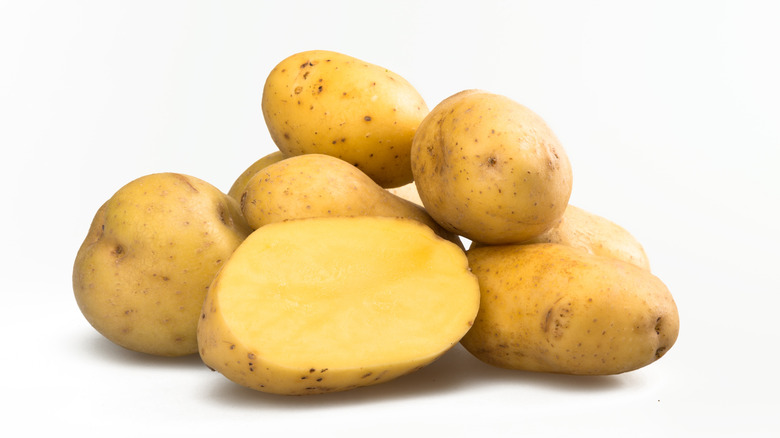When it comes to dietary choices, carbohydrates often take center stage, evoking a mélange of opinions among health enthusiasts. One particular starchy delight, the Yukon Gold potato, has established itself as a favorite amongst home cooks and health aficionados alike. But how does this versatile tuber measure up in terms of glycemic load? Buckle up as we embark on this edible exploration that may just challenge your preconceived notions.
Understanding Glycemic Index and Glycemic Load
Before we delve into the specifics of Yukon Gold potatoes, it’s essential to familiarize ourselves with two pivotal concepts: glycemic index (GI) and glycemic load (GL). The glycemic index is a measure that ranks foods based on how they affect blood glucose levels after consumption; foods are scored on a scale from 0 to 100. Foods with a high GI, typically above 70, provoke a more pronounced spike in blood sugar compared to their low GI counterparts.
However, merely relying on the glycemic index can be misleading. This is where glycemic load comes into play. Glycemic load takes into account both the quality and quantity of carbohydrates in a serving size, making it a more nuanced parameter for judging a food’s impact on blood sugar. It is calculated using the formula: (GI × carbohydrate content per serving) / 100.
For instance, a food that has a high glycemic index but is consumed in small amounts may have a lower glycemic load. This distinction is critical when evaluating the nutritional ramifications of Yukon Gold potatoes.
Yukon Gold Potatoes: Nutritional Profile
Let’s examine what a typical Yukon Gold potato brings to the table. These potatoes present a modest caloric content, providing approximately 110 calories per medium-sized tuber. Each serving boasts a commendable offering of vital nutrients, including potassium, vitamin C, and B vitamins, alongside a plethora of dietary fiber.
In terms of carbohydrates, a medium Yukon Gold potato contains roughly 26 grams. With such statistics at hand, one cannot help but question: how does this translate into glycemic load, and what implications does that carry for our health?
The Glycemic Load of Yukon Gold Potatoes
With a glycemic index estimated between 56 and 60, Yukon Gold potatoes fall into the mid-range category, indicating a more moderate effect on blood sugar levels compared to high-GI foods like white bread or sugary cereals. To derive its glycemic load, consider that a medium serving (approximately 150 grams) contains around 26 grams of carbohydrates. Using the formula mentioned earlier, we can reckon that the glycemic load for a typical serving of Yukon Gold potatoes is approximately 15. This categorizes them as a moderate glycemic load food.
What Does This Mean for You?
At this juncture, you might be contemplating the implications of this glycemic load on your personal health journey. Understanding the GL of Yukon Gold potatoes might provoke a playful challenge: can you incorporate this nutritional powerhouse into your meals while managing your carbohydrate intake? The moderate glycemic load suggests that they can be enjoyed without a drastic impact on blood sugar levels, particularly when consumed as part of a balanced meal, rich in proteins and healthy fats.
Moreover, when Yukon Gold potatoes are prepared with the skin on, the fiber content increases, thereby further mitigating spikes in glycemic response. This underscores the importance of how one prepares and pairs their potatoes: think roasted Yukon Golds with a sprinkle of olive oil and rosemary, or creamy mashed potatoes tempered with Greek yogurt for added protein.
Portion Control: The Key to Enjoyment
As tempting as it may be to indulge in a heaping plate of Yukon Golds, portion control is paramount. Moderation is the cornerstone of a healthy eating pattern. A serving size of one medium potato aligns with dietary guidelines, allowing you to savor the creamy texture and buttery flavor without veering into the high glucose territory.
Consider how you can complement your servings: a side of steamed vegetables or a fresh salad can help balance the meal while heightening nutritional value. By challenging yourself to create vibrant, well-rounded dishes, you can relish the rich taste of Yukon Gold potatoes without fear of exceeding carbohydrate limits.
Potential Health Benefits
Beyond their glycemic attributes, Yukon Gold potatoes possess an array of health benefits that warrant attention. The high potassium content plays a crucial role in cardiovascular health, aiding in blood pressure regulation. Furthermore, the presence of antioxidants promotes cellular health and reduces inflammation, making these potatoes a valuable addition to a holistic diet.
Additionally, Yukon Gold potatoes can serve as an excellent canvas for culinary creativity. From baked to sautéed, the possibilities are endless. So ask yourself: how will you master the art of cooking with Yukon Gold potatoes to reap their health benefits?
Conclusion: A Tasty Dilemma
The glycemic load of Yukon Gold potatoes presents a deliciously intriguing dilemma: how do you incorporate this nutrient-rich carbohydrate into your diet while maintaining a mindful approach to glycemic impact? This tuber is more than just a comfort food; it poses a playful challenge to engage with your meals thoughtfully.
Ultimately, Yukon Gold potatoes can be enjoyed as part of a balanced dietary framework, promoting satisfaction and health. Arm yourself with knowledge on portion control and preparation methods, and you’re well-equipped to navigate the tantalizing world of Yukon Gold potatoes. So, what culinary quest will you embark upon next with this delightful starch? The culinary stage is yours.

